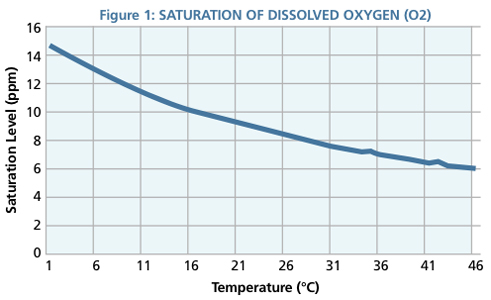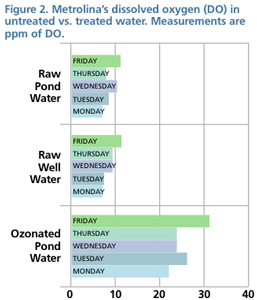1/29/2016
Understanding Dissolved Oxygen
Kurt Becker
Even the non-technical growers have an understanding and appreciation for the measurements used in greenhouse growing today. Monitoring and optimization of pH and Electrical Conductivity (EC) have become standard practice, improving plant health and quality throughout the industry. By measuring these two simple factors, most nutritional problems can be avoided. The measurement of Dissolved Oxygen (DO) is also proving to be just as critical to plant growth. As with the other two measurements, there are minimum levels required for a healthy plant. Also, by optimizing DO, as with pH and EC, we can see great improvements in plant growth and quality. However, far fewer growers are utilizing, or are even aware, of this measurement.
Many of the practices in botany already consider the effect that oxygen has on the root zone. In the field, we till the soil. Among other things, this adds air space to provide oxygen to the roots. In horticulture, growing media is selected with a consideration for porosity for the same reason. The benefits of oxygen to plant roots, and to the rhizosphere in general, is well established in the mind of the grower. However, most are unaware of the level of oxygen contained in their irrigation water and don’t realize that there are methods to improve this level.
Dissolved oxygen is simply the amount of oxygen (O2) dissolved in water. It’s one of the best indicators of the quality, and the life-supporting ability, of water. People need the right amount of oxygen in the atmosphere to survive. And, just as fish need the right amount of dissolved oxygen in the water to survive and thrive, so do plants.
Measured in mg/l, as a percent of saturation (%) or in parts per million (ppm), dissolved oxygen levels are affected by the temperature and salinity of the water, and also by other chemical and/or biological demands (COD/BOD) of the water. Cold water can hold more dissolved oxygen than warm water (see Figure 1) and fresh water can hold more dissolved oxygen than salt water. The maximum amount of DO that the water can hold is called the saturation value. It’s possible, and very often desired—especially in a greenhouse—to exceed the natural saturation point of DO in water. This is called super-saturation.

At levels around 5 mg/l of dissolved oxygen, irrigation water is typically considered marginally acceptable for plant health. Most greenhouse crops, however, will perform better with higher levels. Levels of 8 mg/l or higher are generally considered to be good for greenhouse production and much higher levels, as high as 30 mg/l or more, are achievable and can be beneficial. If the DO levels are below 4 mg/l, the water is hypoxic and becomes very detrimental, possibly fatal, to plants and animals. If there’s a severe lack of DO, below around 0.5 mg/l, the water is anoxic. No plants or animals can survive in anoxic conditions. The irrigation water in many greenhouses has surprisingly low levels—often in the dangerous hypoxic range.
Unfortunately, without measurement and awareness of the dissolved oxygen in greenhouse irrigation water, problems caused by hypoxic water in plant growth often go undiagnosed or misdiagnosed. Happily, monitoring DO is fairly easy. Just as with pH and EC meters, there’s a wide range of devices available at varying quality, accuracy and ease-of-use to test the level of dissolved oxygen in water.
When measuring DO, it’s important to understand the oxygen demand in the irrigation system and in the roots. There are plenty of things that will use oxygen in this environment. This is the reason that you might test 8mg/l DO at a cistern or well head, but only 5mg/l at the plant. Organic material in the water, or biofilm in your pipes, will consume oxygen. For this reason, it’s important to test in multiple locations and look for ways to remove as much of the biological demand as possible.
However, the detrimental effects of low-dissolved oxygen levels shouldn’t be the only reason to measure. Increasing DO in irrigation water can not only prevent problems, but with super-saturated levels, it can increase quality and plant growth, reducing cropping time and overall health. High levels of dissolved oxygen promote healthy root growth. The root system requires oxygen for aerobic respiration, an essential process that releases the energy required for healthy root growth and a healthy plant.
Research shows that higher dissolved oxygen levels in the root zone of most crops results in a higher root mass. A plant with more root mass grows healthier and faster. A plant’s roots are where it gets the majority of its inputs for growth, including water and nutrients. Healthy roots with a good supply of oxygen have better respiration and are able to selectively absorb more ions in solution, such as the vital mineral salts nitrogen, phosphorus and potassium. When there’s less oxygen in the water than there is in the plant, this reduces the permeability of roots to water, therefore reducing (even reversing) the absorption of nutrients.
A healthier plant is a more efficient plant
DO isn’t just an additional nutrient one should pay more attention to because it makes a healthier plant; there are direct economic impacts, as well. When used properly, it can reduce the amount of nutrients and micronutrients required, as well as the amount of costly chemicals, such as fungicides. Additionally, evidence suggests that plant growth increases with super-saturation levels of DO, reducing cropping times and increasing fruiting or flowering yields.
Improving levels of dissolved oxygen can be done through various methods. Simple aeration or agitation can increase dissolved oxygen enough to prevent problems. Injecting air or, especially, pure oxygen can increase levels as well, but only as high as saturation levels. Paying attention to temperature can also help improve DO, as colder water can hold more oxygen. Additionally, water at atmospheric pressure will hold less oxygen than when under pressure. Think of a bottle of carbonated water: while under pressure, the water holds more carbon dioxide than it can when the cap is removed and the pressure is released. Once the bottle is opened, the CO2 begins to gas-off from the water, effervescing. The same is true with oxygen. Adding oxygen to a pressurized system can increase the level of DO.
Ozonation is another method for increasing oxygen levels in solution. Like oxygen injection, injecting ozone gas will increase dissolved oxygen. However, ozone or O3 is almost 13 times more soluble in water than O2. This allows for much greater levels of oxygen to be dissolved into the water. As O3 is very unstable and reverts back to O2 quickly, it leaves super-saturated levels of dissolved oxygen in the water. As the system remains under pressure, the DO levels can be maintained at more than 300% of the saturation level of DO.
While adding dissolved oxygen, ozone has an additional benefit in that it oxidizes organic material and biofilm in the pipes, reducing the oxygen demand and helping to maintain higher levels of DO.
Putting it to the test
Trials were conducted at Metrolina Greenhouses in Huntersville, North Carolina. Utilizing a portable water-treatment unit consisting of filtration and ozonation, the benefits of water super-saturated with dissolved oxygen were tested against their standard water sources. Three greenhouses were tested side-by-side using identical benching and booms. One used their pond water, one used their well water and the third used their pond water treated with the trial system. Consistently, the plugs in the third greenhouse using the ozone treatment had higher germination rates, faster cropping times, better root growth (see photo) and better leaf development. Measurement of their dissolved oxygen in the irrigation water used in the third house was 300% greater than in the other two houses (see Figure 2).
In a final summary of the trial and of their first year using their own, complete treatment system, Metrolina reported that they saw an average of two weeks shorter cropping time on most liners, with complete cropping time reductions up to four weeks. More robust root systems with less damage and more drought tolerance were noted, as well as the removal of all biofilm from filters and pipes, and an overall reduction in their shrink by 66% from their previous three-year average.
These results are extremely impressive and achievable by others with proper equipment. However, growers can improve the health of their water in the short term by simply paying attention to the dissolved oxygen in their water. At a minimum, monitoring DO in irrigation water can help prevent problems or suggest different courses of action as problems arise.
In the long run, the ability to optimize oxygen levels could improve plant health quality, reduce crop times and eliminate shrink, just as the focus on other input optimization has in the past.
GT
Kurt Becker is the Executive Vice President—Sales & Marketing at the Dramm Corporation in Manitowoc, Wisconsin.